Proteases Market Size
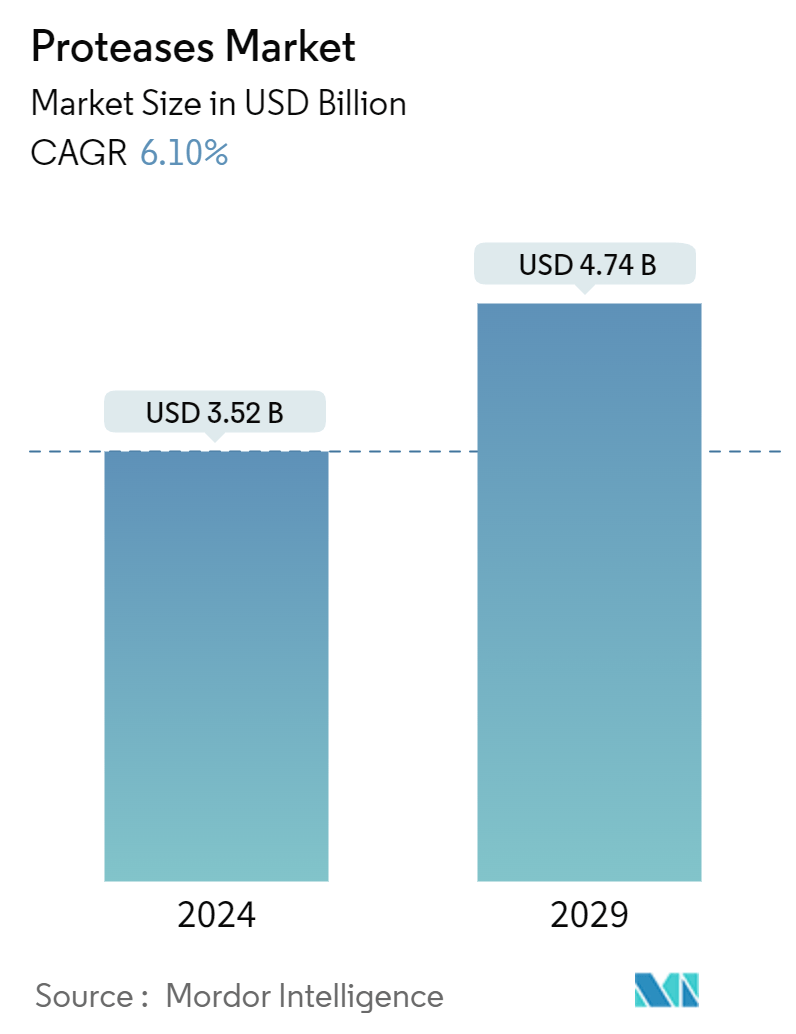
| Study Period | 2019 - 2029 |
| Market Size (2024) | USD 3.52 Billion |
| Market Size (2029) | USD 4.74 Billion |
| CAGR (2024 - 2029) | 6.10 % |
| Fastest Growing Market | Middle East and Africa |
| Largest Market | North America |
| Market Concentration | High |
Major Players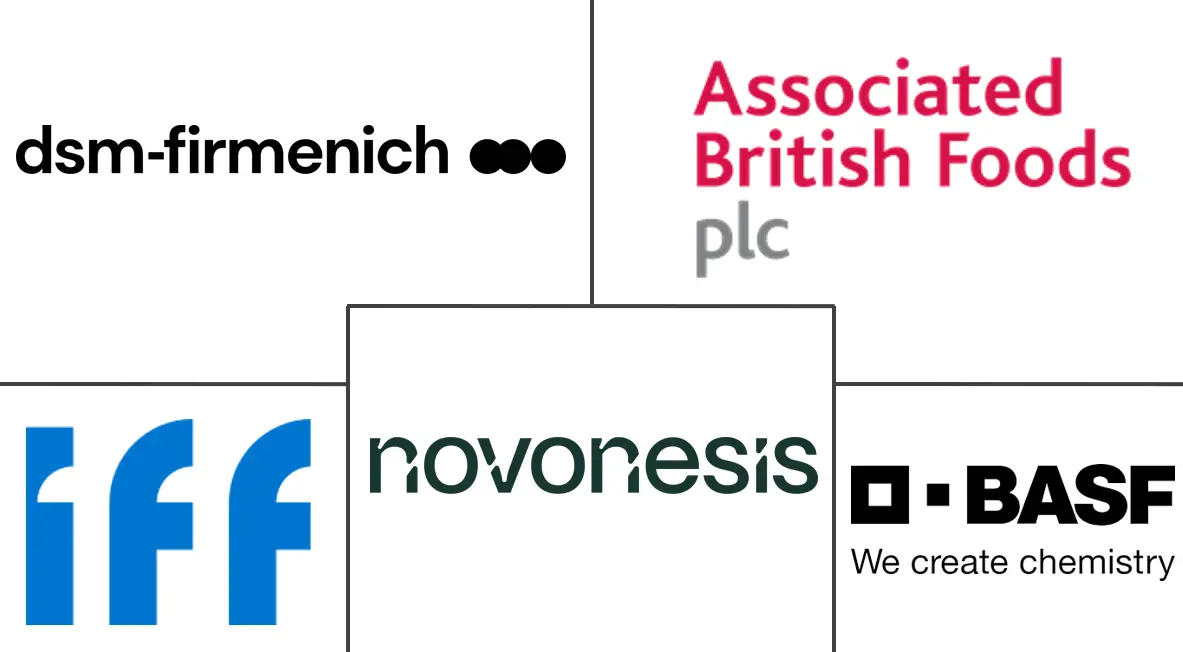
*Disclaimer: Major Players sorted in no particular order |
Proteases Market Analysis
The Proteases Market size is estimated at USD 3.52 billion in 2024, and is expected to reach USD 4.74 billion by 2029, growing at a CAGR of 6.10% during the forecast period (2024-2029).
The global processed food industry is experiencing significant growth, driven by changing consumer lifestyles that demand ready-to-cook/eat products. This is expected to drive the demand for proteases during the forecast period. Additionally, microbial proteases have gained interest due to their vital role in metabolic activities and their immense utilization in industries. The proteases available in the market that are of microbial origin offer higher yield, lower time consumption, and cost-effectiveness, which have made them suitable for biotechnological applications in the market.
Proteases are a diverse group of enzymes that act as proteinases, peptidases, and amidases and have a broad range of industrial applications, particularly in the food, detergent, and pharmaceutical industries. Proteases are essential industrial enzymes that break down peptide bonds in proteins and find numerous uses in chemical and biological processes. One of the main advantages of using proteases is their ability to produce natural products, exhibit activity under mild reaction conditions, and exhibit stereospecificity, specificity, and biodegradability. Companies have introduced innovative products that reduce reaction time to enhance overall yield. Proteases are crucial in developing many fast-moving consumer good (FMCG) products. The market's primary driver is the multiple applications of proteases in various industries. Additionally, their non-toxic and non-pathogenic attributes make them eco-friendly, further boosting the market.
Proteases are used in the animal feed industry to improve the nutritional content and digestibility of feed, which promotes better animal growth and general health. Proteases facilitate the easier absorption of complex proteins in the digestive tracts of animals like pigs, poultry, and aquaculture species by breaking them down into simpler peptides and amino acids. In addition to improving the effectiveness of nutrient utilization, this enzymatic action also lessens the anti-nutritional elements that may impede absorption and digestion. Furthermore, by reducing the need for high-protein feed ingredients, proteases can reduce feed costs and the environmental impact of animal production by reducing nitrogen excretion. According to the Bundesanstalt für Landwirtschaft und Ernährung, approximately 1.53 million tons of dressed-weight poultry were produced across Germany in 2023. The expansion of the animal husbandry industry and rising demand for animal feed offer ample opportunities for the protease market worldwide.
Proteases Market Trends
Rising Application of Proteases in the Food & Beverage Industry Driving Market Growth
In the food industry, proteases are widely used to enhance various food products' texture, flavor, and nutritional value. Proteases such as papain and bromelain break down muscle fibers to tenderize tough cuts and produce more succulent meat during meat processing. The high consumption of meat across various regions worldwide offers ample opportunities for the growth of protease demand in the meat and poultry industry. According to the US Department of Agriculture and Economic Research Service, in 2022, the per capita consumption of broilers, beef, and pork was 98.9 pounds, 59.1 pounds, and 51.1 pounds, respectively.
Enzymes like chymosin found in rennet are essential for the production of cheese and dairy products as they aid in the coagulation of milk and the formation of curds, as well as enhancing the flavor of the cheese as it ages. Proteases have applications in the baking industry since they alter the structures of gluten, enhancing the dough's elasticity and consistency, which are important qualities for baked goods like biscuits and crackers. Proteases remove proteins that cause haze in beer brewing, guaranteeing its stability and clarity. Similarly, these enzymes are necessary for the production of juice, which removes turbidity caused by proteins to produce clear drinks. Hence, proteases are widely used across the food and beverage industry.
Companies operating in the market have been innovating and developing new products. They are also using other strategies to test and develop new proteases to cater to the rising demand for the same. For instance, in September 2022, Creative Enzymes launched Kex2 Protease from Saccharomyces cerevisiae, Recombinant, for the cleavage of secreted peptides in yeast exogenous protein expression. Protease enzymes have diverse applications in the food and beverage industries. The market is expected to grow significantly in the upcoming years due to its vital role in reducing waste production, improving processing efficiency, and preserving natural resources.
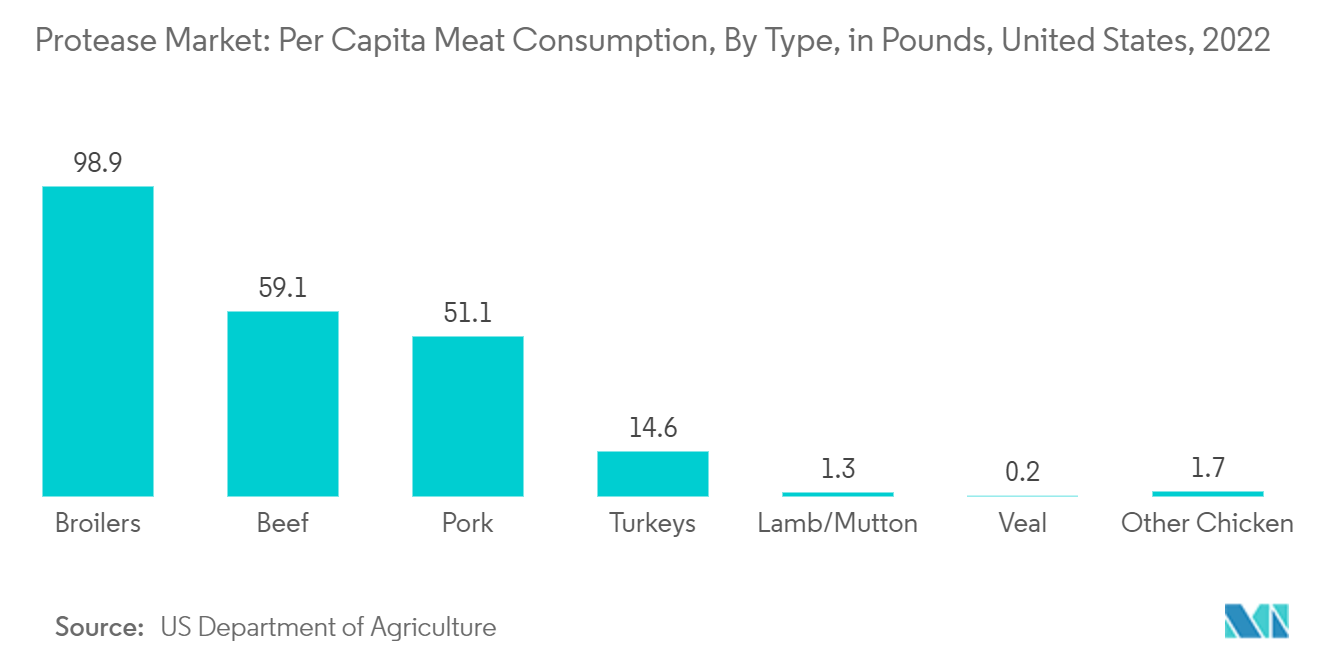
North America Dominates the Proteases Market
North America is host to advanced biotechnology and pharmaceutical industries that use proteases for drug development, protein engineering, and therapeutic uses. For instance, in March 2023, Danisco Animal Nutrition & Health, a business unit of IFF, launched Axtra PRIME (a combination of xylanase, beta-glucanase, alpha-amylase, and protease enzymes), an optimized enzyme blend designed to address key challenges in piglet production. Proteases are used extensively in a variety of applications by the large and sophisticated food and beverage industry in North America. Proteases are utilized, for instance, in the brewing process, cheese production, and meat tenderization. Proteases are used by businesses like Anheuser-Busch InBev and Kraft Heinz to improve product quality and processing effectiveness.
The development and commercialization of protease-based products, particularly in food and pharmaceuticals, are supported by the regulatory environment provided by the US Food and Drug Administration (FDA). Protease efficacy and safety are guaranteed by this regulatory support, which increases market acceptance. Protease usage has increased in products due to the growing demand for functional foods and health supplements. There is a growing demand for nutraceuticals in North America as consumers become more conscious of the health benefits of proteases. According to the National Library of Medicine, while the predominant use of proteases has been in treating cardiovascular disease, they are also emerging as useful agents in the treatment of sepsis, digestive disorders, inflammation, cystic fibrosis, retinal disorders, psoriasis, and other diseases.
Hence, the protease market leadership of North America is fueled by strong industrial demand, innovative technology developments, a benevolent regulatory framework, significant R&D expenditure, and a wide range of applications in various industries. All these elements work together to support the regional market's leading position and steady expansion.
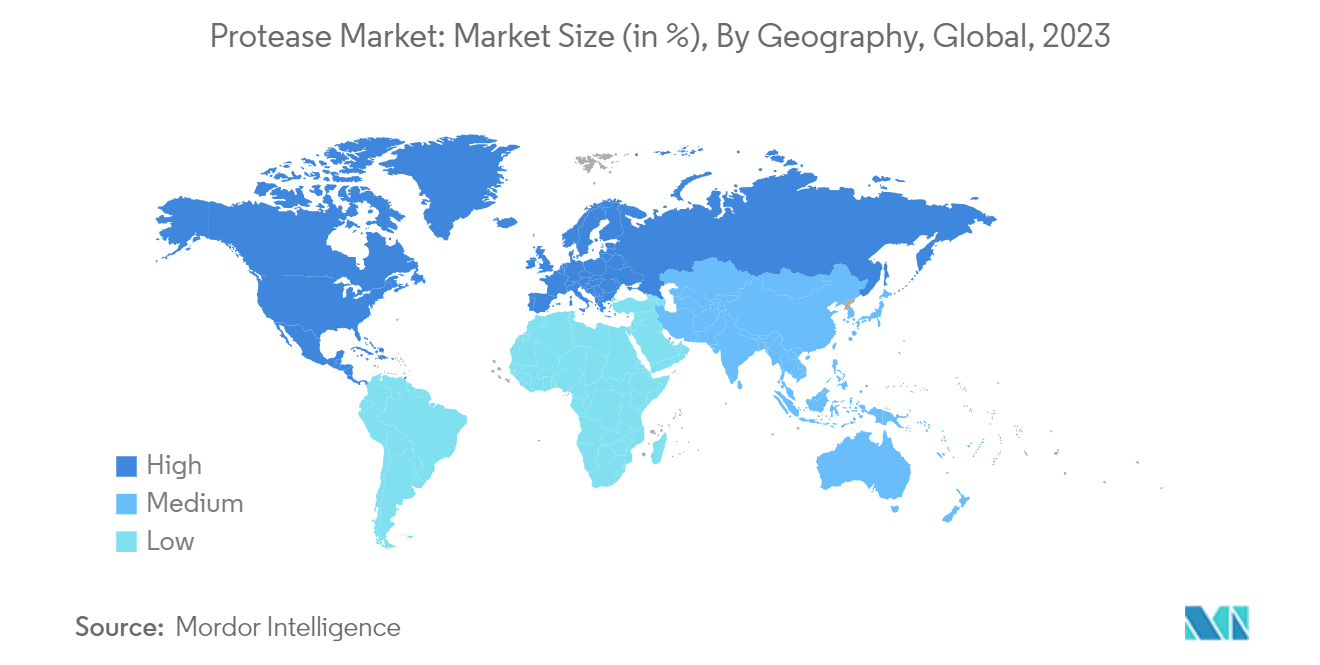
Proteases Industry Overview
The protease market is consolidated in nature, with the top players occupying major market shares. Some of the major players in this market include International Flavors & Fragrances Inc., DSM-Firmenich AG, Novonesis Group, BASF SA, and Associated British Foods PLC. These players adopt various strategies to maintain their leading position in the market and build a strong brand image. The key strategies these players adopt include mergers and acquisitions, which help them consolidate their market position and expand their product portfolios.
Product innovation and new product development are essential strategies adopted by top players to cater to consumer demand and preferences. Companies invest heavily in research and development activities to introduce new and improved products, which help them differentiate their products from their competitors and expand their customer base. Moreover, companies also focus on expanding their product portfolios by adding new product lines and acquiring new businesses. This strategy enables companies to cater to consumers' evolving needs and preferences and increase their market share.
Proteases Market Leaders
-
International Flavors & Fragrances, Inc.
-
BASF SE
-
DSM-Firmenich AG
-
Novonesis Group
-
Associated British Foods PLC
*Disclaimer: Major Players sorted in no particular order
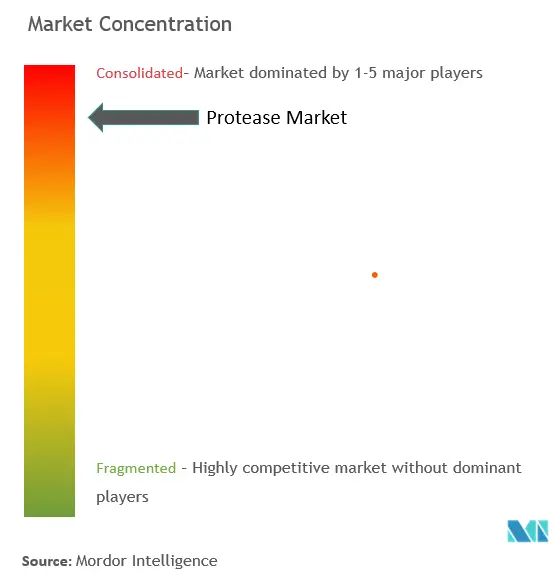
Proteases Market News
- July 2023: Biocatalysts Ltd launched its new protease preparation, Promod 128L, developed specifically with a unique formulation of endopeptidase activities for the effective hydrolysis of extracted collagen in producing neutral-tasting collagen peptides.
- June 2023: BASF expanded its innovation campus in Shanghai for the development of two new research and development (R&D) buildings. The company invested around EUR 280 million.
- January 2023: Danisco Animal Nutrition & Health, a business unit of International Flavors & Fragrances, received approval from the Canadian Food Inspection Agency (CFIA) for Enviva PRO and Syncra SWI. Syncra SWI is a combination of VMP and a protease enzyme, and the company claims that it is an effective feed additive with an agile enzyme-producing capacity that adapts to different feed ingredients.
Protease Market Report - Table of Contents
1. INTRODUCTION
1.1 Study Assumptions and Market Definition
1.2 Scope of the Study
2. RESEARCH METHODOLOGY
3. EXECUTIVE SUMMARY
4. MARKET DYNAMICS
4.1 Market Drivers
4.1.1 Technological Advancements in Enzyme Engineering & Bioprocessing
4.1.2 Growing Inclination Toward Specialty and Sustainable Ingredients
4.2 Market Restraints
4.2.1 High Production Costs Impede Market Growth
4.3 Porter's Five Forces Analysis
4.3.1 Threat of New Entrants
4.3.2 Bargaining Power of Buyers/Consumers
4.3.3 Bargaining Power of Suppliers
4.3.4 Threat of Substitute Products
4.3.5 Intensity of Competitive Rivalry
5. MARKET SEGMENTATION
5.1 Source
5.1.1 Animal
5.1.1.1 Trypsin
5.1.1.2 Pepsin
5.1.1.3 Renin
5.1.1.4 Other Animal Sources
5.1.2 Plant
5.1.2.1 Papain
5.1.2.2 Bromelain
5.1.2.3 Other Plant Sources (Keratinases and Ficin)
5.1.3 Microbial
5.1.3.1 Alkaline Protease
5.1.3.2 Acid Protease
5.1.3.3 Neutral Protease
5.2 Application
5.2.1 Food and Beverage
5.2.1.1 Dairy
5.2.1.2 Bakery
5.2.1.3 Beverages
5.2.1.4 Meat and Poultry
5.2.1.5 Infant Formula
5.2.2 Pharmaceuticals
5.2.3 Animal Feed
5.2.4 Other Applications
5.3 Geography
5.3.1 North America
5.3.1.1 United States
5.3.1.2 Canada
5.3.1.3 Mexico
5.3.1.4 Rest of North America
5.3.2 Europe
5.3.2.1 Spain
5.3.2.2 United Kingdom
5.3.2.3 France
5.3.2.4 Germany
5.3.2.5 Italy
5.3.2.6 Rest of Europe
5.3.3 Asia-Pacific
5.3.3.1 China
5.3.3.2 Japan
5.3.3.3 India
5.3.3.4 Singapore
5.3.3.5 Australia
5.3.3.6 Rest of Asia-Pacific
5.3.4 South America
5.3.4.1 Brazil
5.3.4.2 Argentina
5.3.4.3 Rest of South America
5.3.5 Middle East and Africa
5.3.5.1 South Africa
5.3.5.2 United Arab Emirates
5.3.5.3 Saudi Arabia
5.3.5.4 Rest of Middle East and Africa
6. COMPETITIVE LANDSCAPE
6.1 Strategies Adopted by Leading Players
6.2 Market Share Analysis
6.3 Company Profiles
6.3.1 Novus International Inc.
6.3.2 International Flavors & Fragrances Inc.
6.3.3 DSM-Firmenich AG
6.3.4 Biocatalyst Ltd
6.3.5 Novonesis Group
6.3.6 Advanced Enzyme Technologies
6.3.7 Associated British Foods PLC
6.3.8 Bioseutica BV
6.3.9 BASF SE
6.3.10 Kemin Industries Inc.
- *List Not Exhaustive
7. MARKET OPPORTUNITIES AND FUTURE TRENDS
Proteases Industry Segmentation
Protease is an enzyme that catalyzes the hydrolysis of peptide bonds present in proteins and has many functions, including industrial and medical purposes, like extracting gums, processing food, and treating inflammation. The protease market is segmented by source, application, and geography. By source, the market is segmented into animal (which is further segmented into trypsin, pepsin, renin, and other animal sources), plant (which is further segmented into papain, bromelain, and other plant sources), and microbial, which is further segmented into alkaline protease, acid protease, and neutral protease. By application, the market is segmented into food and beverage (which is further segmented into dairy, bakery, beverages, meat and poultry, and infant formula), pharmaceuticals, animal feed, and other applications. By geography, the market is segmented into North America, Europe, Asia-Pacific, South America, and Middle East and Africa. The market sizing has been done in value terms (USD) for all the abovementioned segments.
| Source | ||||||
| ||||||
| ||||||
|
| Application | |||||||
| |||||||
| Pharmaceuticals | |||||||
| Animal Feed | |||||||
| Other Applications |
| Geography | ||||||||
| ||||||||
| ||||||||
| ||||||||
| ||||||||
|
Protease Market Research FAQs
How big is the Proteases Market?
The Proteases Market size is expected to reach USD 3.52 billion in 2024 and grow at a CAGR of 6.10% to reach USD 4.74 billion by 2029.
What is the current Proteases Market size?
In 2024, the Proteases Market size is expected to reach USD 3.52 billion.
Who are the key players in Proteases Market?
International Flavors & Fragrances, Inc., BASF SE, DSM-Firmenich AG, Novonesis Group and Associated British Foods PLC are the major companies operating in the Proteases Market.
Which is the fastest growing region in Proteases Market?
Middle East and Africa is estimated to grow at the highest CAGR over the forecast period (2024-2029).
Which region has the biggest share in Proteases Market?
In 2024, the North America accounts for the largest market share in Proteases Market.
What years does this Proteases Market cover, and what was the market size in 2023?
In 2023, the Proteases Market size was estimated at USD 3.31 billion. The report covers the Proteases Market historical market size for years: 2019, 2020, 2021, 2022 and 2023. The report also forecasts the Proteases Market size for years: 2024, 2025, 2026, 2027, 2028 and 2029.
Protease Industry Report
Statistics for the 2024 Proteases market share, size and revenue growth rate, created by ����vlog��ý™ Industry Reports. Proteases analysis includes a market forecast outlook to for 2024 to 2029 and historical overview. Get a sample of this industry analysis as a free report PDF download.



